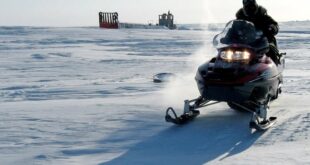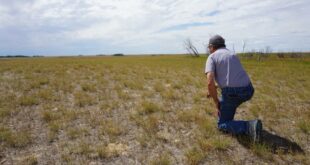Possible showers in some areas on Monday evening could bring reprieve.

Hundreds of wildfires continue to burn across B.C. as hot, dry conditions fan the flames of fires in the province’s Interior.
Showers fell on B.C.’s South Coast most of Monday, while Environment Canada is forecasting the chance of showers in some parts of the Interior Monday evening and on Tuesday, which could help bring some relief to areas hard hit by fires.
Rain is forecast for parts of northern B.C. through the week.
As of Monday afternoon, there are nearly 500 wildfires in the province, many of which were sparked in the past three days. More than half are considered out of control.
There are 23 fires of note, or fires that are considered highly visible or pose a threat to human safety.
Among those is the Ross Moore Lake wildfire, burning in the small farming community of Knutsford, B.C., just 24 kilometres south of Kamloops. It covers 26 square kilometres and has prompted the Thompson-Nicola Regional District (TNRD) to order the evacuation of 344 properties.

Intense B.C. wildfire season still has ‘a long way to go,’ official says
Mike McCulley, a fire information officer with B.C. Wildfire Service, said ‘the numbers speak for themselves’ in terms of how severe the wildfire season has been in the province this year.
Knutsford rancher Doug Haughton told CBC News that the fire has grown “immensely” since it was discovered on July 21. As he spoke on Monday morning, he said he could hear helicopters passing overhead helping with firefighting efforts. The B.C. Wildfire Service says 38 firefighting personnel are battling the blaze with the help of heavy equipment and air support.
Hundreds of people from other provinces and countries are in B.C. helping fight fires, including some from Mexico, Australia and Brazil.
Regional district information officer Colton Davies said smoke from the Ross Moore Lake fire is “extremely visible” from both the Coquihalla Highway and Highway 5A, and strong winds blowing northeast fanned the growth of the fire and spread smoke over Kamloops and other communities.
Davies said the region’s high temperatures and low humidity created an environment for the fire to spread quickly over the weekend, and the threat is persisting.
“We are expecting, just looking at the forecast, more winds today, which is never ideal for fire situations,” he said.
Haughton, director of Thompson-Nicola Regional District (TNRD) Electoral Area L, says he worked all day Sunday to evacuate livestock from his ranch as the fire approached.
The wildfire is burning in many of his neighbours’ yards.
“I haven’t been hit too hard yet, I’m not going to complain,” he said. “Everybody along Long Lake Road … is at risk.”
He said ash falling from the sky is starting spot fires.
Haughton’s neighbour Tammy Osborne, who owns a pet resort in Knutsford, didn’t wait for an evacuation order to close her business and evacuate.
“We’ve got 68 pets that are boarding,” she told Daybreak Kamloops guest host Doug Herbert. “I’m not waiting.”
Two hours after deciding to leave, the animals had been evacuated, thanks to help from neighbours, customers and employees.
Now, she is in the nearby community of Cherry Creek, where a former kennel business there has opened up their home to Osborne, her husband and their pets.
“The support was so amazing.”
New fire of note near Invermere
A new fire near Invermere was discovered on Monday and was quickly classified as a wildfire of note. Dubbed the Horsethief Creek wildfire, it is located seven kilometres north of the Panorama Mountain Resort and 10 kilometres west of the District of Invermere.
As of Monday night, the fire was about 0.7 square kilometres.
The fire is suspected to be caused by lightning, as have most fires so far this season. Gusting winds are contributing to wildfire behaviour, according to the wildfire service.
Wind a concern for fire in East Kootenay
To the east, officials are watching the wind as they continue fighting a wildfire north of Cranbrook, B.C.
The St. Mary’s River wildfire is sitting at roughly 40 square kilometres in size to the west of the Crownsnest Highway, but officials said gusts of up to 50 km/h could push the flames beyond their current borders later Monday.
“We do have a big system that is meant to come in tonight — Environment Canada calling for gusts of up to 50 km/h, so that is the big focus … not just for us in the regional emergency operations centre, but obviously for the crews that are out in the field as well,” said Loree Duzcek, information officer with the Regional District of East Kootenay’s emergency operations centre.
No precipitation is in the forecast for the area, according to Environment Canada.

More than 670 properties north of the city are on evacuation alert, as is the Canadian Rockies International Airport. More than 50 properties are under an evacuation order.
“When the fire lays down, it doesn’t feel as visual, so it doesn’t feel as urgent sometimes to people as when they’re seeing something more dynamic, but people are certainly aware that there’s a fire in the aware and we’re just encouraging anyone that is on alert that they’re staying prepared,” said Duzcek.
Residents urged to be vigilant
The province is reminding British Columbians to follow regional fire prohibitions and local water restrictions as wildfire risks and drought throughout the province remain extreme.
The Ministry of Emergency Preparedness and Climate Readiness says that most of the province is classified as drought Level 4 or 5 and says water conservation must continue, including shorter showers, watering lawns sparingly and turning the tap off when brushing teeth or washing dishes.

For those in areas affected by wildfires, the ministry says they should be paying close attention to evacuation orders and alerts issued by regional districts and First Nations and following those instructions.
“By not leaving, you risk not only the health and safety of you and your family but also of first responders who may need to come back to help you,” the ministry said in a statement.
As of July 24, about 1,030 people have been ordered to evacuate from their homes in B.C., and 3,700 people are under an evacuation alert.
ABOUT THE AUTHOR
Journalist
Courtney Dickson is a journalist in Vancouver, B.C. Email her at courtney.dickson@cbc.ca with story tips.
With files from Rhianna Schmunk, Daybreak Kamloops and The Canadian Press
*****
Credit belongs to : www.cbc.ca
 Atin Ito First Filipino Community Newspaper in Ontario
Atin Ito First Filipino Community Newspaper in Ontario






